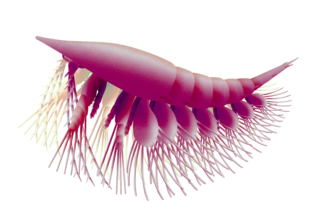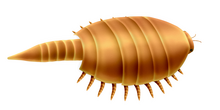
Sidneyia is an extinct marine arthropod known from fossils found from the Early to the Mid Cambrian of China and the Mid Cambrian Burgess Shale of British Columbia, Canada.

Arthropleura is a genus of massive myriapod that lived in what is now Europe and North America around 345 to 290 million years ago, from the Viséan stage of the lower Carboniferous Period to the Sakmarian stage of the lower Permian Period. It is related to millipedes, and was capable of reaching at least 2 metres in length, possibly up to over 2.5 metres, making it the largest known land arthropod of all time. Arthropleura is known from body fossils as well as trace fossils, particularly giant trackways up to 50 centimetres (20 in) wide, and potentially also large burrows. It lived in open, sparsely wooded environments near water, and was possibly amphibious.

Canadaspis is an extinct genus of bivalved Cambrian arthropod, known from North America and China. They are thought to have been benthic feeders that moved mainly by walking and possibly used its biramous appendages to stir mud in search of food. They have been placed within the Hymenocarina, which includes other bivalved Cambrian arthropods.

Waptia is an extinct genus of arthropod from the Middle Cambrian of North America. It grew to a length of 6.65 cm (3 in), and had a large bivalved carapace and a segmented body terminating into a pair of tail flaps. It was an active swimmer and likely a predator of soft-bodied prey. It is also one of the oldest animals with direct evidence of brood care. Waptia fieldensis is the only species classified under the genus Waptia, and is known from the Burgess Shale Lagerstätte of British Columbia, Canada. Specimens of Waptia are also known from the Spence Shale of Utah, United States.

Fuxianhuia is a genus of Lower Cambrian fossil arthropod known from the Chengjiang fauna in China. Its purportedly primitive features have led to its playing a pivotal role in discussions about the euarthropod stem group. Nevertheless, despite being known from many specimens, disputes about its morphology, in particular its head appendages, have made it one of the most controversial of the Chengjiang taxa, and it has been discussed extensively in the context of the arthropod head problem.

Bassipterus is a genus of eurypterid, an extinct group of aquatic arthropods. Bassipterus is classified as part of the family Adelophthalmidae, the only clade within the derived ("advanced") Adelophthalmoidea superfamily of eurypterids. Fossils of the single and type species, B. virgnicus, have been discovered in deposits of the Late Silurian age in West Virginia and Maryland, United States. The genus is named after Bass, where most of the fossils have been recovered.

Euthycarcinoidea are an enigmatic group of extinct, possibly amphibious arthropods that ranged from Cambrian to Triassic times. Fossils are known from Europe, North America, Argentina, Australia, and Antarctica.

Chuandianella ovata is an extinct bivalved arthropod that lived during Cambrian Stage 3 of the Early Cambrian. It is the only species classified under the genus Chuandianella. Its fossils were recovered from the Chengjiang Biota in Yunnan, China.

Kiisortoqia soperi is an extinct species of arthropod from the Early Cambrian Sirius Passet Lagerstätte in Greenland. While it had a superficially trilobite-like bodyform, it also possessed large frontal appendages similar to those of radiodonts.

Strabops is a genus of strabopid, an extinct group of arthropods. Strabops is known from a single specimen from the Late Cambrian of the Potosi Dolomite, Missouri, collected by a former professor, Arthur Thacher. It is classified in the family Strabopidae of the monotypic order Strabopida, a group closely related to the aglaspidids with uncertain affinities. The generic name is composed by the Ancient Greek words στραβός, meaning "squinting", and ὄψῐς, meaning "face".

Paleomerus is a genus of strabopid, a group of extinct arthropods. It has been found in deposits from the Cambrian period. It is classified in the family Strabopidae of the monotypic order Strabopida. It contains two species, P. hamiltoni from Sweden and P. makowskii from Poland. The generic name is composed by the Ancient Greek words παλαιός (palaiós), meaning "ancient", and μέρος (méros), meaning "part".

Dvulikiaspis is a genus of chasmataspidid, a group of extinct aquatic arthropods. Fossils of the single and type species, D. menneri, have been discovered in deposits of the Early Devonian period in the Krasnoyarsk Krai, Siberia, Russia. The name of the genus is composed by the Russian word двуликий (dvulikij), meaning "two-faced", and the Ancient Greek word ἀσπίς (aspis), meaning "shield". The species name honors the discoverer of the holotype of Dvulikiaspis, Vladimir Vasilyevich Menner.

Squamacula is an extinct artiopodan arthropod from the Cambrian Series 2. The type species S. clypeata was described in 1997 from the Chengjiang biota of Yunnan, China. At the time of description there were only two known specimens of S. clypeata, but now there are at least six known specimens. In 2012 a second species S. buckorum was described from the Emu Bay Shale of Australia.

Retifacies abnormalis is an extinct arthropod that lived in the lower Cambrian. Its fossil remains have been found in the Maotianshan Shales of Yunnan, China. It is a member of the Artiopoda, and closely related to Pygmaclypeatus.
Bushizheia yangi is an extinct species of arthropod known from a single specimen found in the Early Cambrian Maotianshan Shales Lagerstätte in China. While it had a superficially trilobite-like bodyform, it also possessed large frontal appendages similar to those of radiodonts. It is morphologically similar to Kiisortoqia to which it is probably closely related.

Oelandocaris is an extinct genus of stem-mandibulate, or possibly a megacheiran, within the family Oelandocarididae.

Setapedites abundantis is an Ordovician offacolid chelicerate from the Fezouata Formation of Morocco.
Mictomerus melochevillensis is a Cambrian euthycarcinoid from the Potsdam Group of Quebec. It is known from 29 specimens, all but one preserved ventrally.

Arenosicaris inflata is a Cambrian phyllocarid from the Blackberry Hill site of Wisconsin, and the oldest phyllocarid known.
Antarcticarcinus pagoda is a late Carboniferous (Gzhelian) to early Permian (Asselian) euthycarcinoid from the Pagoda Formation of Antarctica.

















